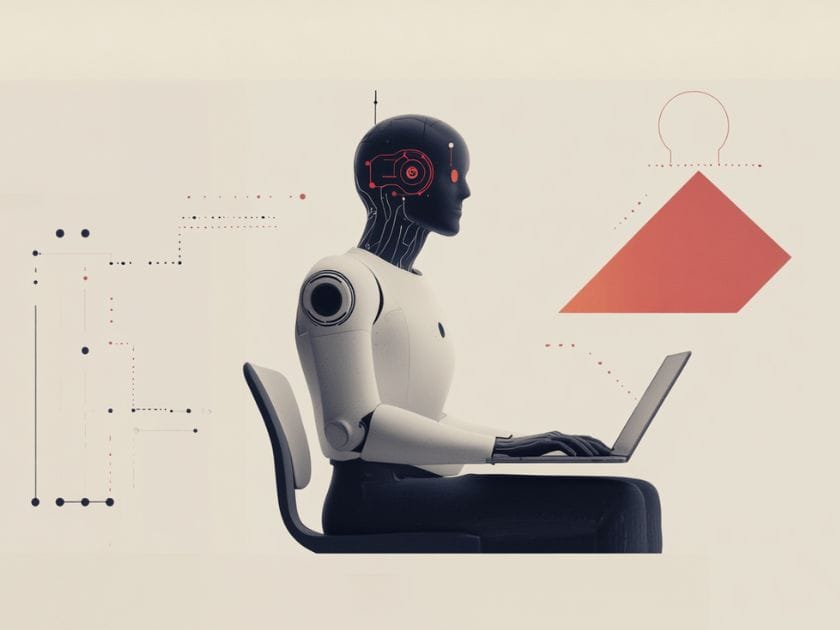AI-Powered Legal Assistance Revolutionizes Access to Justice
Key Takeaways
- AI-powered legal assistants are changing the legal landscape by automating tasks, increasing efficiency, and improving access to legal services.
- AI is used in various areas of law, including personal injury, legal research, contract analysis, and litigation support.
- Core technologies behind AI legal assistants include natural language processing, machine learning, and expert systems.
- Ethical considerations, such as bias and fairness, and limitations, like the scope of machine understanding, need to be addressed as AI continues to evolve in the legal field.
AI-powered legal assistance is changing how lawyers work. These digital tools help with tasks like research, document drafting, and case management. They use smart technology to speed up work that used to take a long time.
AI legal assistants can answer questions, explain laws, and even help write legal papers. This saves lawyers time and helps them focus on the most important parts of their job. Some popular AI legal helpers include DoNotPay, Latch, and ChatLegal.
As these tools get better, they might change how law firms run. They could make legal help cheaper and easier to get for more people. But there are still questions about how to use AI in law in a fair and ethical way.

Evolution of AI in Legal Practice
AI has transformed legal practice over the past several years. It has changed how lawyers work and deliver services to clients. AI tools now handle many tasks that lawyers used to do manually.
Historical Milestones
In the 1980s, lawyers started using basic computer programs for legal research. By the 1990s, digital databases made case law searches faster. The 2000s saw the rise of e-discovery tools to sort through electronic files.
In the 2010s, machine learning entered the legal field. AI could now spot patterns in contracts and predict case outcomes. Law firms began using chatbots to answer client questions.
The late 2010s brought natural language processing advances. AI could understand legal texts better. This led to smarter legal research and contract analysis tools.
Current Trends in Legal AI
AI assistants now help lawyers draft documents and review contracts. They can spot issues human lawyers might miss. Some AI tools can even predict how judges may rule on cases.
E-discovery AI has become very advanced. It can find relevant documents much faster than humans. This saves time and money in big lawsuits.
AI is also changing how lawyers bill clients. It can track time spent on tasks more accurately. Some firms now use AI to set fairer prices for legal services.
Ethics and bias in legal AI are hot topics. Lawyers must make sure AI tools don’t discriminate or make unfair decisions.
AI is transforming personal injury law but cannot fully replace human lawyers. Law firms increasingly adopt AI tools to enhance efficiency and improve case outcomes. However, AI has limitations that make human lawyers essential in personal injury cases.
How AI is Revolutionizing Personal Injury Law
Artificial intelligence transforms how personal injury attorneys fight for their clients’ rights. AI tools are becoming indispensable assets in modern law practices, from predictive analytics to automated document review. Let’s explore how this technology reshapes personal injury litigation while examining its limitations and potential.
The Game-Changing Impact of AI in Personal Injury Cases
Today’s leading personal injury firms leverage AI to maximize case outcomes and streamline operations. Advanced AI systems are analyzing millions of past cases to predict settlement values accurately. Document management platforms powered by machine learning can process thousands of medical records, police reports, and witness statements in hours rather than weeks.
Legal research platforms enhanced by AI now scan countless precedents and statutes in seconds, identifying relevant cases that human researchers might miss. Risk assessment algorithms help attorneys make data-driven decisions about which cases to take and how to allocate resources effectively. Meanwhile, settlement management systems use predictive modeling to suggest optimal negotiation strategies based on historical data.
Understanding AI’s Current Limitations in Personal Injury Law
While AI offers powerful capabilities, it cannot replace the essential human elements of personal injury representation. Personal injury cases often involve complex circumstances that require nuanced interpretation of laws and precedents. An experienced attorney understands how subtle factors like witness credibility, jury composition, and local legal culture can impact case outcomes in ways that AI cannot fully grasp.
Perhaps most importantly, personal injury lawyers provide crucial emotional support to clients facing life-altering injuries. They offer compassionate guidance through traumatic experiences and advocate passionately for their clients’ interests. These deeply human aspects of representation simply cannot be replicated by artificial intelligence.
AI systems also raise important ethical considerations. Questions about data privacy, algorithmic bias, and transparency in AI decision-making must be carefully addressed. Additionally, while AI can process vast amounts of data to inform settlement discussions, the art of negotiation still requires human judgment, creativity, and emotional intelligence.

Core Technologies Behind AI Legal Assistants
AI legal assistants use advanced technologies to process legal information and assist lawyers. These systems rely on natural language processing, machine learning, and expert systems to analyze documents and provide insights.
Natural Language Processing
Natural language processing (NLP) allows AI legal assistants to understand and interpret human language. This technology helps the systems read legal texts and extract key information.
NLP algorithms can identify important concepts, entities, and relationships in legal documents. They can parse complex sentences and understand legal jargon.
Advanced NLP models can also generate human-like responses to legal queries. This enables AI assistants to engage in conversational interactions with lawyers and clients.
Machine Learning and Analytics
Machine learning powers the analytical capabilities of AI legal assistants. These systems use large datasets of legal information to recognize patterns and make predictions.
Supervised learning algorithms can classify documents, identify relevant cases, and spot potential issues in contracts. Unsupervised learning helps cluster similar documents and find hidden connections in legal data.
Analytics tools process vast amounts of legal data to reveal trends and insights. They can predict case outcomes, estimate settlement values, and analyze judicial decisions.
Expert Systems
Expert systems in AI legal assistants encode legal knowledge and reasoning. These rule-based systems capture the expertise of experienced lawyers to provide guidance on specific legal issues.
They use if-then rules to apply legal principles to different scenarios. Expert systems can help with tasks like contract review, regulatory compliance checks, and legal risk assessment.
Some advanced expert systems use fuzzy logic to handle the nuances and uncertainties in legal reasoning. This allows them to provide more flexible and context-aware advice.

Applications in Legal Research
AI-powered tools are transforming legal research. They help lawyers find relevant cases, analyze legal trends, and interpret statutes more efficiently.
Case Law Search
AI systems can search through vast databases of legal cases in seconds. They spot key facts and legal principles that match a lawyer’s query. These tools go beyond simple keyword searches. They use natural language processing to grasp the context and meaning of legal texts.
AI assistants can:
- Find similar cases based on facts or legal issues
- Rank results by relevance
- Highlight important passages
- Suggest related cases not directly mentioned
This saves lawyers hours of manual searching and reading. It helps them build stronger arguments and find precedents they might have missed.
Legal Analytics
AI tools crunch data from past cases to spot trends and patterns. This gives lawyers insights into:
- How specific judges tend to rule
- Success rates for different legal strategies
- Typical settlement amounts in similar cases
- Time frames for different types of cases
These insights help lawyers make more informed decisions. They can better advise clients on likely outcomes and craft more effective strategies.
Some AI systems can even predict case outcomes based on past data. While not perfect, these predictions give lawyers a useful starting point for risk assessment.
Statutory Interpretation Assistance
AI helps lawyers make sense of complex laws and regulations. These tools can:
- Break down dense legal language into simpler terms
- Link relevant statutes to related case law
- Flag potential conflicts between different laws
- Track changes in laws over time
This helps lawyers stay up-to-date with changing regulations. It also reduces the risk of missing important legal requirements.
AI assistants can quickly answer questions about specific laws. This speeds up research and helps lawyers focus on applying the law to their case.

AI in Contract Analysis and Management
AI tools are transforming how legal professionals handle contracts. These systems can quickly analyze documents, flag issues, and help manage the contract lifecycle.
Review and Due Diligence
AI-powered contract analysis software scans documents to find key information. It can pick out important clauses like termination terms or confidentiality agreements. This speeds up the review process and reduces human error.
Some tools use natural language processing to understand contract text. They can compare contracts to standard templates and spot unusual terms. This helps lawyers focus on the most important parts of each agreement.
AI systems also assist with due diligence by analyzing large sets of contracts. They can identify patterns and potential risks across many documents. This is especially useful for mergers and acquisitions.
Risk and Compliance Monitoring
AI helps monitor contracts for ongoing compliance and risk. These systems can track important dates like renewal deadlines or payment schedules. They send alerts when action is needed.
The software can also check if contract terms match current regulations. It flags any clauses that might violate laws or company policies. This helps businesses stay compliant and avoid legal issues.
AI tools can analyze contract performance data. They spot trends that might indicate increased risk. For example, they can identify vendors who often miss deadlines or quality targets.
The Role of AI in Litigation Support
AI tools are changing how lawyers handle cases. They help with research, document review, and predicting case outcomes. These tools make legal work faster and more accurate.
Predictive Analysis
AI can predict how a case might turn out. It looks at past court decisions and finds patterns. This helps lawyers make better choices about their cases.
AI tools can estimate the chances of winning a lawsuit. They can also suggest how much money a case might be worth. This helps lawyers decide if they should settle or go to trial.
Lawyers use AI to plan their legal strategies. The tools show which arguments might work best. This saves time and improves the chances of success in court.
E-Discovery
E-discovery uses AI to find important documents for a case. It can search through millions of files quickly. This is much faster than having people read every document.
AI can spot key information in emails, texts, and other files. It learns to find patterns and important words. This helps lawyers find the evidence they need.
E-discovery tools can also group similar documents together. This makes it easier for lawyers to review the information. It cuts down on the time and cost of preparing for a trial.

Ethical Considerations and Governance
AI-powered legal assistance raises important ethical issues. These include fairness, privacy, and regulatory compliance. Each area requires careful attention to ensure responsible use of AI in law.
Bias and Fairness
AI systems can reflect biases in their training data or design. This may lead to unfair outcomes for certain groups. Legal AI tools must be tested for bias before use. Regular audits help catch issues.
Developers should use diverse datasets. This helps create more balanced AI models. Lawyers need to understand how AI makes decisions. They must be able to explain results to clients and courts.
Oversight is key. Human lawyers should review AI outputs. They can spot potential biases or errors the system may have missed.
Data Privacy and Security
AI legal tools often handle sensitive client information. Strong data protection is crucial. Encryption and access controls safeguard confidential data.
Law firms must follow data privacy laws. This includes rules like GDPR in Europe. Client consent is needed before using their data in AI systems.
Secure storage prevents data breaches. Regular security updates protect against new threats. Staff training on data handling is also important.
Regulatory Compliance
AI in law must follow professional ethics rules. Bar associations are creating guidelines for AI use. These cover issues like lawyer supervision and client disclosure.
Some jurisdictions require transparency about AI use in court. Lawyers must understand when and how to disclose AI involvement. They should be ready to explain AI methods if asked.
AI tools need ongoing monitoring. This ensures they stay compliant as laws change. Firms should have clear policies on AI use. These policies help staff use AI responsibly.
Challenges and Limitations of AI in Law
AI legal tools face hurdles in fully grasping complex legal concepts and being held accountable for decisions. These issues can limit their effectiveness in certain legal tasks.
Scope of Machine Understanding
AI struggles to interpret nuanced legal language and context. It may miss subtle details in contracts or laws that human lawyers easily spot. Legal cases often involve complex human factors that AI can’t fully grasp.
AI relies on past data, which can be biased or outdated. This can lead to flawed predictions in rapidly changing areas of law. New laws or precedents may not be reflected in AI’s knowledge base.
Natural language processing still has limits in understanding legal jargon and intricate phrasing. This can result in misinterpretations of key legal points.
Dependability and Accountability
AI systems lack human judgment and ethical reasoning abilities. They can’t fully weigh moral implications of legal decisions. This limits their use in sensitive or high-stakes cases.
Errors in AI legal analysis can have serious consequences. It’s hard to hold an AI system accountable for mistakes. This raises concerns about liability and fairness in AI-assisted legal work.
AI’s decision-making process is often opaque. This “black box” nature makes it tough to explain or challenge AI-generated legal advice. Transparency is crucial in legal matters, especially in court.
Cybersecurity risks pose threats to confidential legal data used by AI. Breaches could compromise sensitive client information or case strategies.

The Future of AI in Legal Services
AI is set to transform legal services in the coming years. It will change how lawyers work and how people access legal help.
Potential Developments
AI tools will get better at analyzing legal documents. They’ll spot key issues faster than humans. Lawyers may use AI to write contracts and briefs more quickly.
Chatbots could answer basic legal questions 24/7. This would help more people get legal info when they need it.
AI might predict case outcomes based on past rulings. This could help lawyers and clients make smarter choices about their cases.
Virtual legal assistants may become common. They could schedule meetings, file papers, and do basic research for law firms.
Impact on Legal Employment
Some worry AI will replace lawyers. But it’s more likely to change how they work. Routine tasks may be done by AI, freeing up lawyers for complex work.
New jobs could appear. Law firms may need tech experts to manage AI systems. AI trainers could help keep legal AI tools up to date.
Lawyers may need new skills. Understanding AI and how to use it could become key for legal careers.
Small law firms could compete better with big ones. AI tools might level the playing field by making research and document prep faster and cheaper.
AI’s Evolving Role in Personal Injury Law
As artificial intelligence continues to advance, we can expect to see even more sophisticated applications in personal injury law. Emerging technologies promise to enhance settlement negotiations through advanced modeling of case variables. AI-powered tools will likely assist in preparing compelling courtroom arguments by analyzing successful presentation strategies. Some systems may even predict judicial tendencies and opposing counsel tactics with increasing accuracy.
However, the future of personal injury law will not be about AI replacing attorneys. Rather, it will be about combining the analytical power of artificial intelligence with the irreplaceable human qualities that great personal injury lawyers bring to their practice. This powerful partnership between human expertise and AI capabilities will help ensure better outcomes for injured clients while maintaining the essential human element of legal representation.
The most successful personal injury firms of tomorrow will be those that effectively balance AI’s analytical capabilities with the human touch that clients need during challenging times. As technology evolves, this harmonious integration of AI tools and human expertise will continue to reshape how personal injury lawyers serve their clients.

